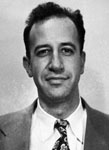Joel Barr

Electrical engineer
Born: New York - 1 January 1916
Died: Moscow - 1 August 1998
The partner of Alfred Sarant, Joel Barr was an American electrical engineer and devoted communist who passed military secrets to the Soviet Union during and after the Second World War, and then fled behind the Iron Curtain, where he became a driving force in the field of Soviet microelectronics, developing, amongst many technical advances, computers that are still used on Russian-built submarines today.
Born in Brooklyn to a Jewish family of Ukrainian immigrants, Barr grew up in extreme poverty, especially during the Great Depression. He went to study electrical engineering at the free City College of New York, at the time the most radical campus in America. He joined the Young Communist League and met Julius Rosenberg. After graduation, he began work at the US Signal Corps Laboratory at Fort Monmouth in New Jersey, working on the new technology of radar, where he met Alfred Sarant. He soon began to pass information through Rosenberg to Soviet spies, but his communist connections soon caught up with him and he was fired on the recommendation of the FBI in 1941. Nonetheless, he managed to find other jobs with defense contractors working on equally secret technologies.
In 1945, Barr enrolled on a Masters program at Columbia University, where he also taught himself to play the piano and studied with the respected American composer Elie Siegmeister. He returned to the defense industry, but soon realized he was being investigated by the FBI, and fled to Europe in 1948. In Paris, he persuaded Oliver Messiaen to take him on as a student, despite his lack of formal musical training. As the FBI began to arrest members of the Rosenberg spy ring, Barr escaped to Czechoslovakia, where he became Iosef Berg, born in South Africa, and married a Czech woman.
Sarant joined Barr in Prague in late 1951, and the pair began working on computerized anti-aircraft weaponry for the Czech army. Both learned to speak Czech in a couple of months, a remarkable feat that they would repeat with Russian five years later when they were called to the Soviet Union, and asked to continue their work at various research organizations in Leningrad. By this time, Sarant had become the dominant member of the partnership, and the pair had great success, their inventions winning many prominent supporters including aircraft designer Andrey Tupolev and Nikita Khruschev, throughout the late 1950s and early 1960s. As a measure of their importance to the Soviet authorities, Barr drew a salary 50 percent higher than a deputy minister.
By the 1970s, as the Soviet Union began to stagnate under Brezhnev, Barr and Sarant found their unusual position increasingly compromised. While Sarant moved to Vladivostok to try to revive his fortunes, Barr remained in Leningrad enjoying an extremely comfortable (by Soviet standards) life, but with few official duties. In the 1980s, his plans for a new system of integrated circuit manufacturing gained government approval, but funds proved lacking as the Soviet Union slowly collapsed. In 1990, Barr returned to the United States in search of funding for his project, travelling as Berg on his Soviet passport. He spent the rest of his life between the US and Russia, managing to obtain a new American passport and Social Security benefits without ever attracting the attention of the US authorities. He died in hospital in Moscow in August 1998, remaining to the end of his life a committed communist.
Connected with: Alfred Sarant

